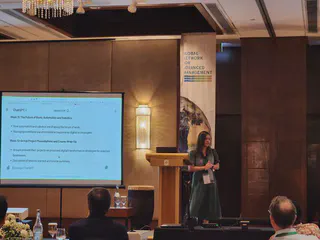Educators+Machines - Reshaping the Future of Business Education

I recently had the honor of serving as one of the keynote speakers at the Global Network for Advanced Management’s (GNAM) deans and directors meeting. This prestigious network unites leading business schools worldwide, enhancing global collaboration and educational exchange. My presentation, titled ‘Educators+Machines: Shaping the Future of Business Education,’ acknowledged the saturation of AI discussions at many conferences (Yes! Yet another AI talk, right?). The challenge was not merely to reiterate familiar concepts but to inject the dialogue with new insights and innovative applications. Aware of the potential fatigue from repeated topics, I aimed to engage our deans and directors by delving deeper into AI and exploring interactive strategies for its integration in educational settings.

Many educators, including colleagues from the Philippines, recognize generative AI’s capabilities but have not engaged deeply with the technology. Noting a common fear of AI’s impact on their roles, stemming from a lack of immersive experience, the session was designed to bridge this gap. My goal was to demystify AI and promote a hands-on understanding of its use in education, encouraging educators to explore its potential confidently.
The AI in Business Education Landscape

Before diving into AI, I shared the concept map I created, inspired by Amy Webb’s talk on strategic foresighting value mapping. This map illustrates the multiple dimensions through which AI impacts business education, a topic colleagues frequently ask me about concerning the ‘Future of Education with AI.’ These questions almost often pushes me to consider which lens to use. Having this map helps streamline my thought process. It includes six core theme that are highly interconnected: Stakeholder Impact, Curricular and Pedagogical Innovation, Ethical Considerations, Career Development and Employment Outcomes, and Technological Integration.
I presented this map to jumpstart the talk, but the focus of my session was on demystifying AI and providing a hands-on, practical approach to generative AI in education.
AI? ML? DL? ChatGPT?

Given my many, many, many interactions with individuals across various sectors, I sensed that many still do not fully understand the relationship among the concepts. So, as a first step, we demystify the terms AI, ML, DL, GenAI, and LLM. We then covered the science of “learning” in ML. The session provided more than just a theoretical overview; it laid a foundation to foster a deeper understanding and to highlight nuances often overlooked in conventional AI in Education talks.
I am convinced that truly understanding the science behind the tools we use is essential; this knowledge allows us to better assess their strengths and limitations. Indeed, most concerns about using AI tools in the classroom stem from a lack of understanding of these tools.
Practical GenAI
We then transitioned to hands-on demonstrations and interactive problem-solving exercises, which I thought was super fun. I had the pleasure of asking our deans and directors to use pen and paper and write a pseudocode 😉 Then, I asked those with access to a LLM to work on the problem, even writing a Python script, allowing them to engage directly with AI tools and experience their potential in real-time.
Again, it’s one thing to hear about how awesome a tool is; no matter how often you hear these praises, you’ll never truly appreciate it until you use it yourself.
The practical engagement was crucial for shifting perceptions and reducing the fear associated with AI technologies. This is something I’ve observed many times after having run multiple ‘Demystifying LLMs for Educators’ sessions at the Asian Institute of Management. By enabling educators to ‘get their hands dirty,’ the session aimed to demonstrate that AI can be an empowering tool rather than a threat. We went through a few more demos, some of which I am sharing on this website I set up for the session.
The overwhelmingly positive feedback confirmed that this approach not only made the session memorable but also effectively addressed the common apprehensions about AI in education.
Takeaway Message
The recurring emphasis throughout our discussion was the importance of mastering AI technologies, arming educators with the knowledge needed to navigate AI’s complexities with their students and prepare them to deploy these tools ethically and proficiently in their upcoming careers.
I left the session excited for our Deans and Directors. The energy and insights garnered from this meeting will undoubtedly advance the quality of business education across the globe.
As I emphasized at the 2024 AACSB ICAM and reiterated in the GNAM meeting, being active users of AI technology ourselves better equips us to participate in discussions on education policies concerning AI. Familiarity with the capabilities and limitations of tools like ChatGPT enhances our understanding and informs our approach to implementing pedagogical innovations. By experiencing firsthand what AI can and cannot do, we are more prepared to guide its integration into educational frameworks effectively.